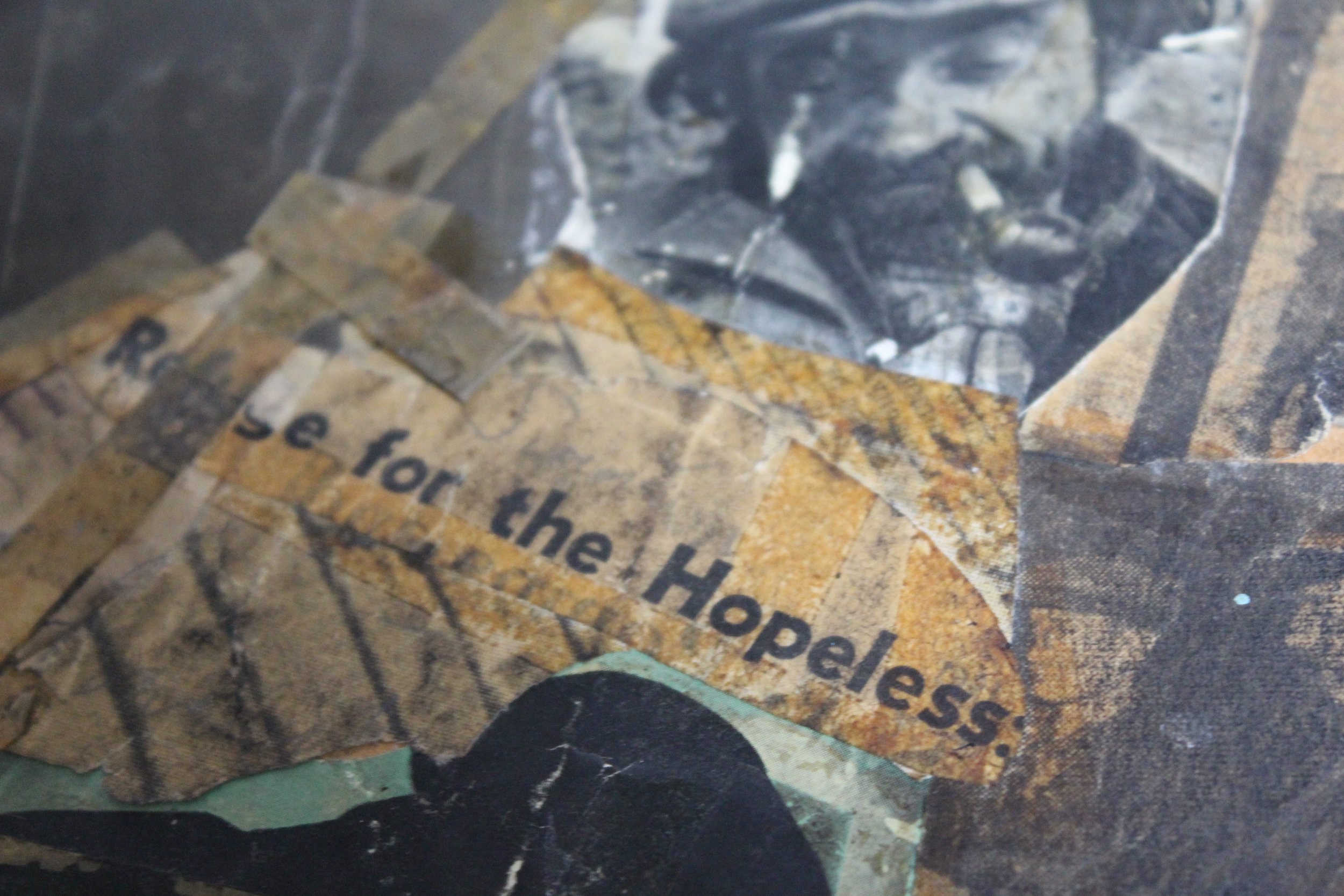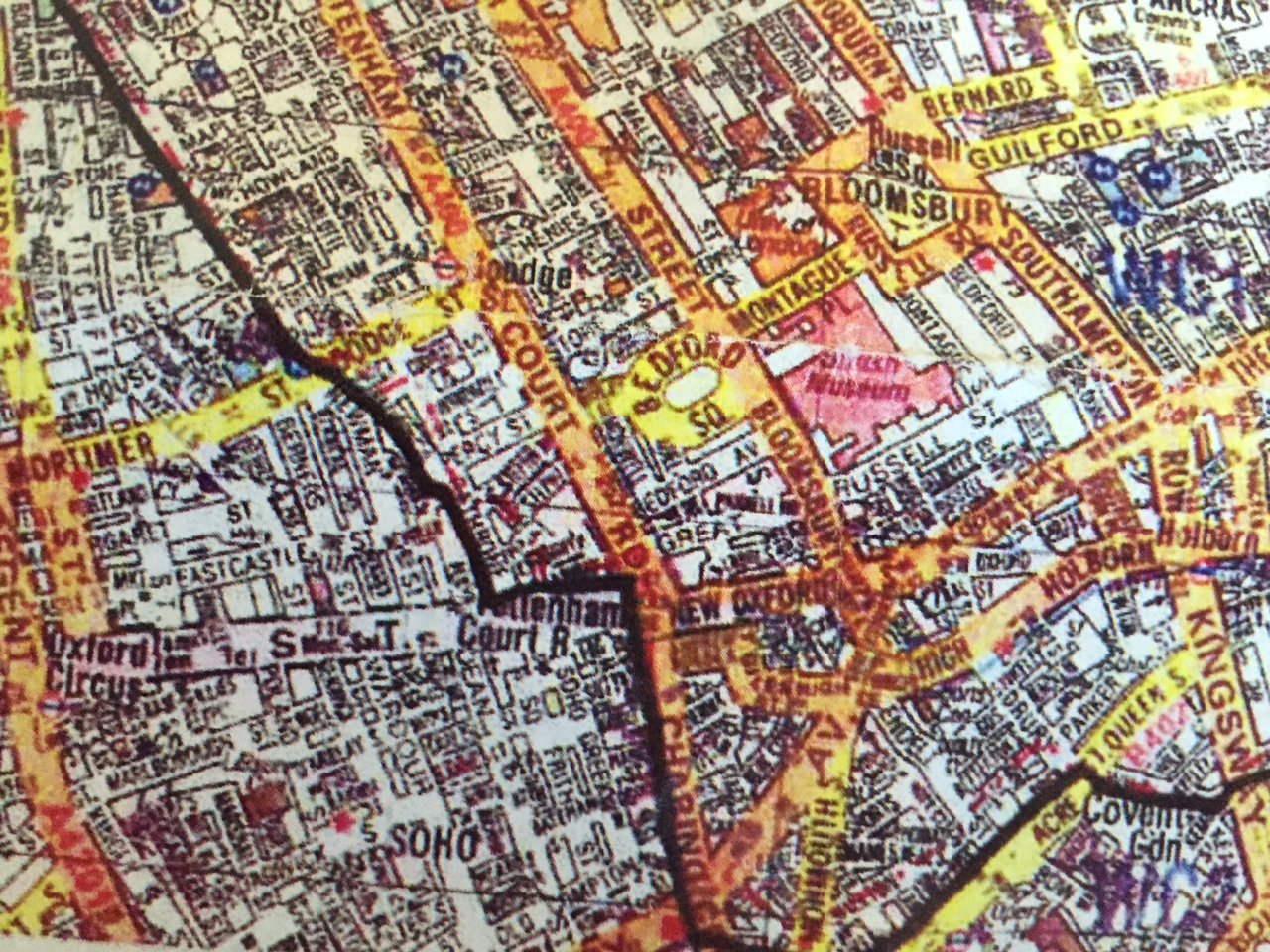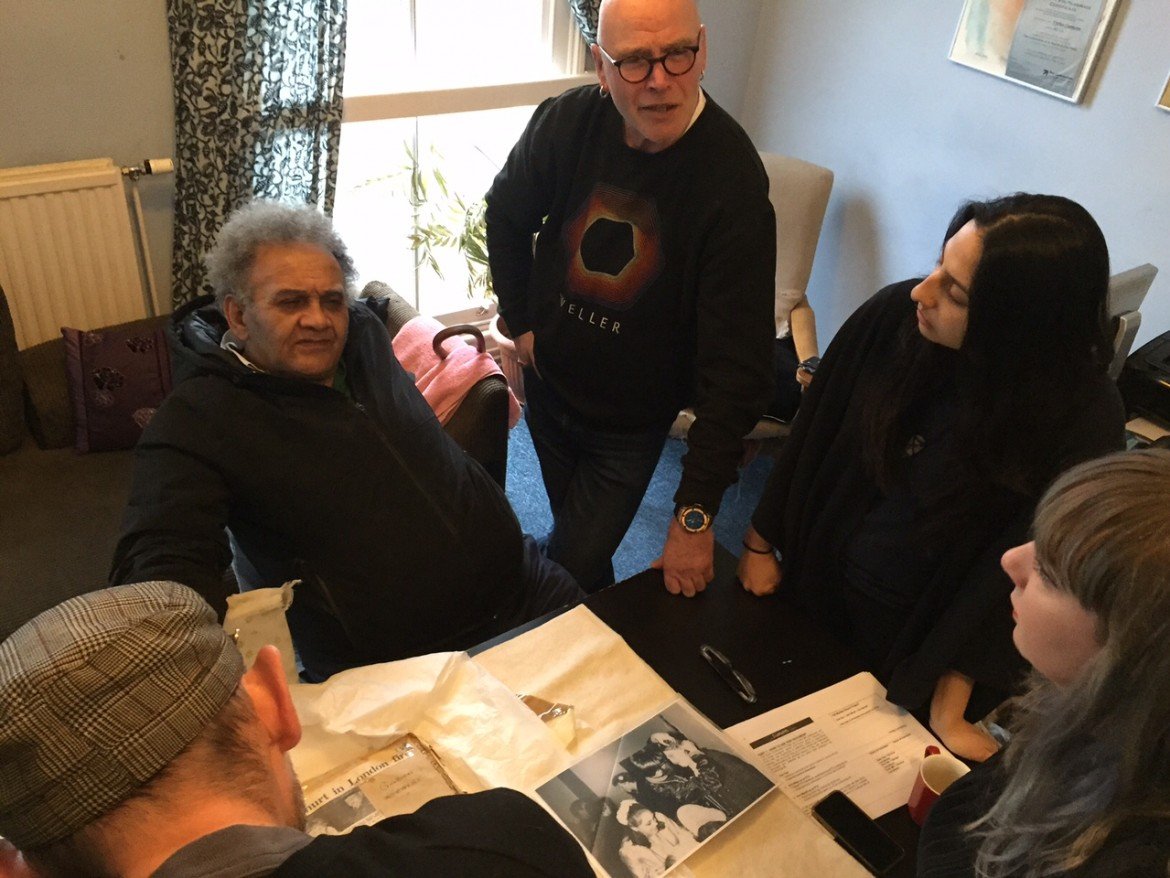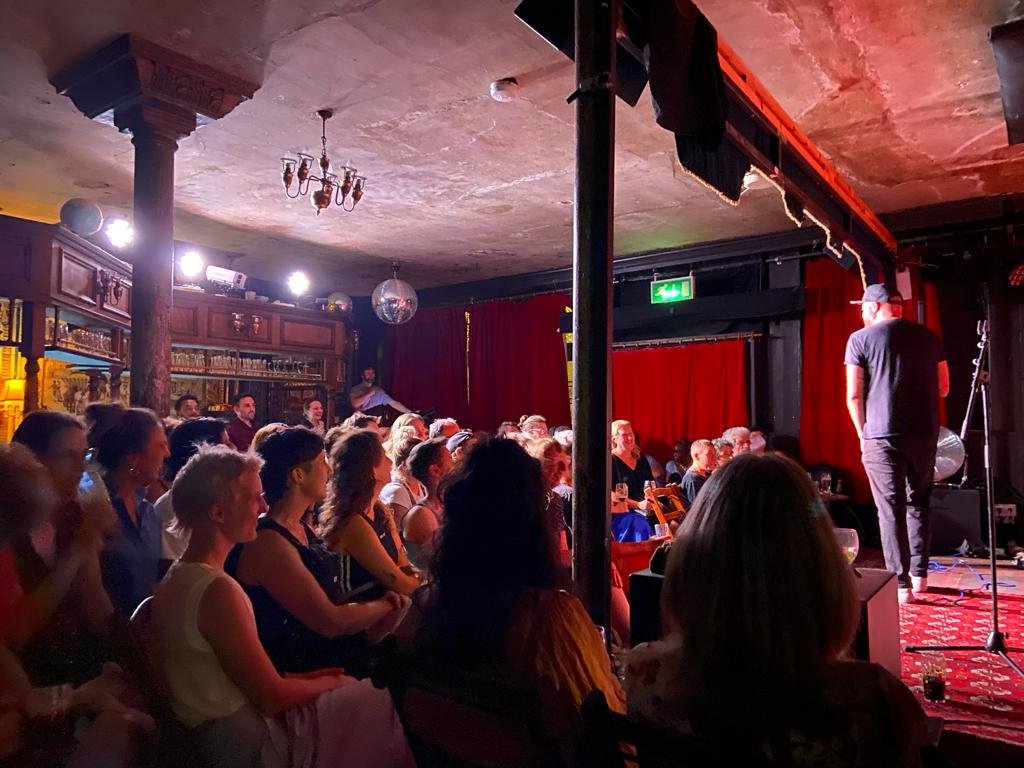
WE MAKE HISTORY
Museum of Homelessness is building the national collection for homelessness, preserving and sharing histories of homelessness, poverty and social action.
The Museum of Homelessness has a small but growing collection of objects and archival records drawn from various organisations, individuals and through its projects. Our focus is on recent history from the post-war period.
This section of the site contains a selection of objects, stories and essays chosen by a range of contributors that say something about homelessness history and what is going on today. We occasionally add new things and anticipate sharing more entries in the coming years.
At the moment we are developing our new space in Finsbury Park. We are currently unable to arrange viewings of the archive but we anticipate this changing after our public opening later in 2024. At the present time we are therefore unable to collect unsolicited donations to the archive and collection.
The Dosser’s Bible 1957-1963
-
1963
Paper
Courtesy of MT Gibson-Watt, Simon Community Archive
Photo: Richard Matthews -
The Dosser’s Bible was assembled throughout the late 1950s and early 1960s by the founder of the Simon Community. Anton Wallich-Clifford. The Community is based in Camden and from 1963 operated houses for the homeless going way beyond the provision offered at the time to work with homeless people beyond the reach of existing provision. Many major homelessness charities including St Mungos and the Cyrenians came out of the Simon Community.
This elaborate scrapbook has the name the ‘Dosser’s Bible’. A provocative title by today’s standards, the name also suggests a kind of alternative comment on the original bible so this is itself a kind of history lesson. What the object actually contains is a vast compendium of articles and clippings that features many of the debates we see in homelessness today. It is part autobiographical and also a striking visual memoir of the time.
The first thing that strikes you is the now rather faded collage that blends religious iconography with images of the city and faces of homeless people. The first page shows two contrasting articles that give two quite distinct positions on the homeless experience. One replays the familiar recovery story of someone who is homeless, and is a daily mirror article about two rough sleepers and how love saved them “from the garden of lost souls”. The other article is a kind of op-ed piece on whether or not we write off homeless people. This last one has a bit of a personal touch in that Anton has highlighted his own projects by underlining them.
The bible itself is offers insight into a time of great change. Throughout there are references to projects Anton was involved, people who inspired and influenced him and ultimately, the coming together of a community inspired to make change for homeless people. Whether it’s men and women of the church or social reformers like Jeremy Sandford, we can see how historically, these movements influenced each other.
Throughout the bible we see articles that consistently refer to the homeless experience that is unchanged today. There are articles covering the difficulties offenders face when coming out of prison, media stereotyping a housing crisis and of course individual recovery stories. Just as the original bible was meant to be a timeless document, the Dosser’s Bible reminds how so many of the debates we see today about homelessness are unchanged. It also reminds us what can be done if people work together to make change.
Noise Matters, May 2018
-
2018
Recording -
On 26 May 2018 a dozen people gathered for a workshop at the Old Diorama Arts Centre, many of the people who came have experienced homelessness. This Noise Matters was a chance to talk about homelessness by thinking about sound and listening. At the end of the day everyone involved was invited to describe a sound of their own to donate to the Museum of Homelessness.
The recording below is a brief record of the conversations we had and the thoughts we shared at the workshop: a kind of miniature archive of everyday sounds. It is also an invitation to think about the sounds that make up your own everyday life. Where do they come from? How are they made? What you would change about them if you could? And how does it feel to listen to someone, and to be listened to?
Listen here.
Sound credits:BBC SFX Archive
At Freesound.org: Robinhood76; squashy555; alanh15; lucy4
Steph Evans – What Is Homelessness? 1978
-
Easter 1978
Paper
Courtesy of MT Gibson-Watt, Simon Community Archive
Photo: Richard Matthews -
In 1978, a paste-up compiled by Steph Evans appeared in the ‘Simon Star’ newsletter with the title ‘what is homelessness’? On a single sheet, this re-produced piece offered 37 definitions about what homelessness is ranging from ‘humiliating’ to the more practical and well understood definitions of ‘being in a state without secure housing’.
This mix of opinion and fact was deliberate, in her definitions Steph sought to attack the inadequate protection offered to homeless people in the 1977 Housing Act. Her paste-up concludes with the question ‘How much more vulnerable must one be to be classed as ‘vulnerable’ within the meaning of the housing (homeless persons’) act of 1977.
How vulnerable would you have to be? If we were to follow Steph’s definitions homelessness could easily mean living from one day to the next or having no-one to talk to. If you scrutinise the definitions closely, the various descriptions begin to stop making sense. As you approach the final definitions homelessness is defined as a business, a profitmaker, a fire hazard and the penultimate ‘can seriously damage your life’.
It would be easy to write off this piece of writing as a just another attack on an entrenched establishment. Yet within the definitions there are some startling hidden truths that offer explanations as to why homelessness persists despite all efforts to wipe it out. Many of these are instantly recognisable but some definitions are more subversive, subjective and entirely one person’s opinion. Yet historically, they speak to realities that can’t be covered by law alone and continue to persist to this day.
The full list of definitions is as follows:
-The state of being without secure housing
-Not having a roof over your head
-Not having a key to your own front door
-If you are “covered” by the housing (Homeless Person) Act, 1977
-If you don’t have a rent book
-If you are going to lose your accommodation within 28 days
-If you have to sleep rough
Stigmatizing
-Isolating
-The creation of a non-entity
-Humiliating
-Loveless
-Being alone
-Having no-one to talk to
-Having no-one to listen to you
-Dehumanizing
-Illegal
-Always your fault
-Not having a voice
-Not having an address
-Not having a councillor
-Not having an M.P
-Not having a representative to speak for you
-Unhealthy
-Not having a doctor
-Not having a dentist
-Not having an optician
-Being refused treatment/admission to hospitals
-Being an ignored statistic
-Living from one day to the next
-A crime
-A business
-A growth industry
-A profitmaker
-A fire hazard
-Can seriously damage your life
-Is vulnerability
The Baccy, 2018
-
2018
Paper and Card
Photo: Steve Bright Creative -
What is it like to be seriously ill and a migrant living on the streets without documentation? Why would a person get called ‘posh homeless’ in the street community? And according to this person’s story, what is the number one thing that helps people who are street homeless smile on a cold winter morning?
In 2018, a packet of tobacco was given to the Museum of Homelessness, along with a story about why it is important and what it represents. This video is a short performance of what the object means, in the words of the person who gave it.
Watch the Object StoryOur heartfelt thanks to the donor of this object, who remains anonymous. This film was directed by Dorothy Allen-Pickard, the Creative Directors were Tony McBride and Jess and Matt Turtle. The object story was performed by Ben Smithies. The object photography was by Steve Bright Creative.
This Stuff Matters Vol. 1, Dec 2017
-
2017
Event Catalogue and Description -
Sitting in a lock-up somewhere in London is a hidden history of homelessness and housing in the UK. This is our collection and archive. It is a history that shows us what has happened on the streets, in hostels, in politics and in people’s lives over the last 70 years.
This Stuff Matters Vol.1 was a takeover of the gallery at Islington Central Library where we worked with the grassroots action organisation Streets Kitchen to share our archive with the public. Held on 09 December 2017, Our team chose 6 special items from the archive that they think offer us something to think about today. These stories referenced histories of hostel closures, the housing crisis, Christmas, animals as well as those who pass away on our streets.
This was a colourful sharing of recent homelessness history that raises questions about what is happening today. Featuring visual archive presentations, conversation and hands on activity, we used historical records, news, maps and photography as an inspiration for sharing the stories of housing and homelessness.
Specially curated by team MoH, this was the first time we have shared these items.
Supported by the Heritage Lottery Fund.
The Picture, 2018
-
2018
Work on Canvas
Photo: Steve Bright Creative -
“When you hear about homelessness it’s all about adults and mental illness, but there’s children out there who literally ain’t asked to be in this position.”
This picture was drawn by a 7 year old living temporarily in a hostel in England. His mother donated it to the collection and shares her experiences with us. Our heartfelt thanks to the donor of this object, who remains anonymous.
This film was directed by Dorothy Allen-Pickard, the Creative Directors were Tony McBride and Jess and Matt Turtle. The object story was performed by Sherrie G Akoto. The object photography was by Steve Bright Creative.
The Bottle, 2018
-
2018
Plastic
Photo: Steve Bright Creative -
“I am not fraudulent, I am not a lawbreaker, I am just a Mum…”
This baby’s bottle was given to the museum by a woman in London recounting her experiences of being threatened with deportation and separation from her baby. She donated it to the collection and shares her experiences with us. Our heartfelt thanks to the donor of this object, who remains anonymous.
Watch the Object Story
This film was directed by Dorothy Allen-Pickard, the Creative Directors were Tony McBride and Jess and Matt Turtle. The object story was performed by Lisa Ogun. The object photography was by Steve Bright Creative.
The Symbol, 2018
-
2018
Glass and Lead
Photo: Steve Bright Creative -
“I suppose, tentatively, it…particularly at the time, when making it, being allowed to make stuff like this, being allowed to be creative, realising that you can make something beautiful, quite simply, was really good for my mental state, back then. And so, yeah, tentatively it’s good for that.”
Our heartfelt thanks to the donor of this object, who remains anonymous.
This film was directed by Dorothy Allen-Pickard, the Creative Directors were Tony McBride and Jess and Matt Turtle. The object story was performed by Kerry Norridge. The object photography was by Steve Bright Creative.
The Nit Comb, 2018
-
2018
Plastic and Metal
Photo: Steve Bright Creative -
“Why did I have this? What does it mean to me? Well, it meant that, even though I may have been in some unsanitary situations, mixing with all sorts of people, it meant that I could do my best to keep myself clean. And, from a metaphorical sense, it was about not letting all sorts of things stick to me, that I was just going through a process and I have to look after myself, keep myself well and clean as possible. Because, it doesn’t last forever, bad things don’t last forever, and soon there’ll be another chapter.”
This comb was given to the museum by recounting experiences of homelessness and the value that can be found in some of the most humble objects. He donated it to the collection and shares his experiences with us. Our heartfelt thanks to the donor of this object, who remains anonymous.
This film was directed by Dorothy Allen-Pickard, the Creative Directors were Tony McBride and Jess and Matt Turtle. The object story was performed by Kerry Norridge. The object photography was by Steve Bright Creative.
The Asbo, 2017
-
2017
Paper
Photo: Anthony Luvera -
“People who I’ve spoken to who are not familiar with homelessness dynamics, I don’t know what the word is, are often shocked to hear that this is a sort of thing that is happening, or don’t understand why people are in that situation. So it’s a two way…but most people are angered when they find out that this is what’s being implemented rather than support. The energy is being spent on the criminal justice system and punishing people rather than supporting them to not fall into that position.”
In this video a Street Outreach worker describes a person being given an Asbo by a police officer while they were sitting on the street together.
Our heartfelt thanks to the donor of this object, who remains anonymous.
This film was directed by Dorothy Allen-Pickard, the Creative Directors were Tony McBride and Jess and Matt Turtle. The object story was performed by Elle Payne. The object photography was by Anthony Luvera, 2017.
The Roundabout, 2018
-
2018
Plastic and Metal
Photo: Steve Bright Creative -
“We’ve all got chapters in our lives: childhood; teens; and then, maybe, relationships; then maybe get married; and then maybe looking at family; and then looking at death – they’re all different chapters within somebody’s life. But, the all-encompassing thing is the person, it’s not the label.”
This is the story of being in and out of hospital 23 times in one year; the roundabout – the back and forth of complicated hospitals, stigma in the system and how you rise above it. This object was given to the museum by recounting experiences of homelessness and the value that can be found in some of the most humble objects. He donated it to the collection and shares his experiences with us. Our heartfelt thanks to the donor of this object, who remains anonymous.
This film was directed by Dorothy Allen-Pickard, the Creative Directors were Tony McBride and Jess and Matt Turtle. The object story was performed by Ben Smithies. The object photography was by Steve Bright Creative.
The Bag, 2018
-
2018
Plastic
Photo: Steve Bright Creative -
“The thing is about it, when it’s pissing down, you’ve got 2 black plastic bags, what you can do you can cut a hole for your head in one end, and that goes over your head and you drag that down. Then with the other plastic bag you can actually form like a hat, so the rain doesn’t run down your neck.”
In this video a man describes the usefulness of a black plastic bag when he was homeless.
Our heartfelt thanks to the donor of this object, who remains anonymous.
This film was directed by Dorothy Allen-Pickard, the Creative Directors were Tony McBride and Jess and Matt Turtle. The object story was performed by Ben Smithies. The object photography was by Steve Brown, 2018.
The Candle, 2018
-
2018
Plastic and Electronics
Photo: Steve Bright Creative -
“A bit of light, a bit of hope. That’s the only way we can bring – if we always bang on, and doom, we are just harbingers, we are not doing anything. But, if there is a candle, if there is hope, and if we put that amongst all that harrowing experiences, it will bring something.”
In this video a health worker discusses health and homelessness and how the candle is a symbol of hope.
Our heartfelt thanks to the donor of this object, who remains anonymous.
This film was directed by Dorothy Allen-Pickard, the Creative Directors were Tony McBride and Jess and Matt Turtle. The object story was performed by Elle Payne. The object photography was by Anthony Luvera, 2017.
The Naloxone, 2017
-
2017
Plastic
Photo: Anthony Luvera
-
‘I’m a heroin addict. I had this used on me. It brought me back from overdose, or I would have been dead. But since I’ve got into recovery and started volunteering with the Simon Community, I’ve had to administer it. I didn’t really put much thought into it. I done it all and it was just kinda instinctive, you know. And then, when I went home that night and realised; that guy’s still alive today. It makes life all worthwhile, you know?’
This video tells the story of the hat, a treasured object.
Our heartfelt thanks to the donor of this object, who remains anonymous.
This film was directed by Dorothy Allen-Pickard, the Creative Directors were Tony McBride and Jess and Matt Turtle. The object story was performed by Ben Smithies. The object photography was by Anthony Luvera, 2017.
The Hat, 2018
-
2018
Fabric
Photo: Anthony Luvera -
“Home. A hat is a home, do you know what I mean? Cos you, where you change your clothes pretty much every single day, your hat you pretty much wear the same one every single day um and it becomes part of you, and that’s what your home does as well, you know you you become part of that place. I think that’s why when people lose their home it’s so difficult to sort of pick yourself back up from because it’s a massive part of who you are.”
This video tells the story of the hat, a treasured object.
Our heartfelt thanks to the donor of this object, who remains anonymous.
This film was directed by Dorothy Allen-Pickard, the Creative Directors were Tony McBride and Jess and Matt Turtle. The object story was performed by Sherrie Cameron-Akoio. The object photography was by Anthony Luvera, 2017.

MUSEUM OF HOMELESSNESS COLLECTION (AND OTHER RESOURCES)
Museum of Homelessness is a small organisation, run almost entirely by volunteers. Although we hold a range of records, objects and art in trust we are still young and don’t have our own space.
Since we don’t have a space and large online database yet, we hope this section will give you more info about what to do if you wish to explore our collection or even give us something.
MUSEUM OF HOMELESSNESS COLLECTION AND ARCHIVE
Our archive and collection holdings are small and can be separated into two parts. The first is a collection of a small number of objects, including personal effects, ephemera, signs, art, and important possessions. A large number of these items were donated by people who have been homeless. These objects have been collected since 2017, and are always collected with an oral testimony. We use this testimony as the basis for interpretation of the object, working with actor storytellers. A number of the stories we have collected are shown on this page and we have just over 40 objects in the collection. These objects have also been used in unique collaborations and projects. In 2023 the collection was used by poet in residence Surfing Sofas for his remarkable album Objects and Concepts.
The second part is a paper-based collection covering a period of history in the mid-twentieth century from the late 1950s to the present day. The mid 20c period was a time when the term 'homelessness' was increasingly being discussed, thought about and debated, not as an inconsequential aspect of poverty, but as a more complicated societal phenomenon. The archive is comprised of records of a number of smaller grassroots and voluntary groups, who have historically operated in the UK.
VISITING OUR COLLECTION AND ARCHIVE
Since we were setup in 2015 we have not had our own space, but it is possible to visit the archive and collection by contacting Matt Turtle (matt@museumofhomelessness.org), to arrange a visit. As we develop our space at Finsbury Park we are not able to organise viewings but this will change later in 2024. We are working to fully catalogue the collection and archive and make it more publicly accessible. We will also be hosting more regular history related events at activities after we open.
Links and other resources
There are some great resources out there for those interested in other histories and homelessness now. Please send us other recommendations if you have them.
Homelessness Now: Invisible People is a great source for opinion. Both Homeless Link and Crisis blog regularly and consistently on policy. We recommend following grassroots, lived experience led organsations such as The Outside Project, Streets Kitchen, Simon Community on social media for unfiltered accounts of what’s happening now on the ground.
Workhouse History: Peter Higginbotham has spent decades researching, documenting and sharing the story of the workhouse in Britain.
History of Social Housing: John Boughton’s Municipal Dreams (now a book) is a comprehensive survey of the rise and fall of social housing in the UK from the slums of 19th century Liverpool to Grenfell. The Social History Sound Archive and social housing history resources are good too. There are some great local projects like Southwark Notes and Cardboard Citizens also created a fantastic legacy resource too from their 2017 Home Truths Project.
Poverty and Vagrancy: The London Lives resource is vital for anyone looking at the social history of poverty from the late 1600s through to the 1800s. Peter Jones’s Stray Voices is a great source of opinion and contains some rich and varied articles. The Connected Histories platform is also great for researchers. Finally, anyone interested in poverty in the 1800s will find Booth’s digitised poverty maps at the LSE a must see.
Squatting and resistance: The ASS is a great source for squatting history and present day news. Check out the brilliant Frestonia archive project here for a history of that famous north-west London squat of the late 1970s. Alex Vasudevan also published a book on the international history of squatting that includes a chapter on the UK. There are also resources that ICA created from their show with Mark ‘Smiler’ Cawson who documented squats in the 1980s. For anyone interested in going back further into history you can find info on the history of the Diggers here. 56a is an amazing squatting archive centre in south London - well worth a visit.
Contemporary Collecting Toolkit (Edited by Ellie Miles, Susanna Cordner, Jen Kavanagh), 2020
Museum of Homelessness cofounders wrote a chapter on working with trauma, p. 22.
LATEST ARCHIVE NEWS

"Move over, 20th century museums. This is the new, 21st century model of how museums should be."
— David Anderson, Director General, National Museum Wales





